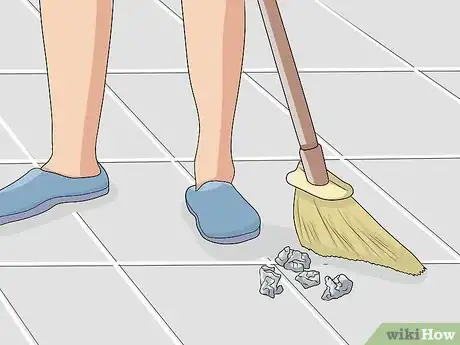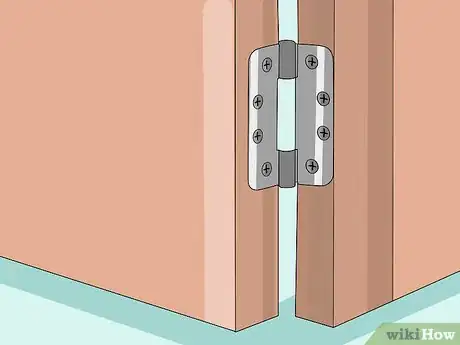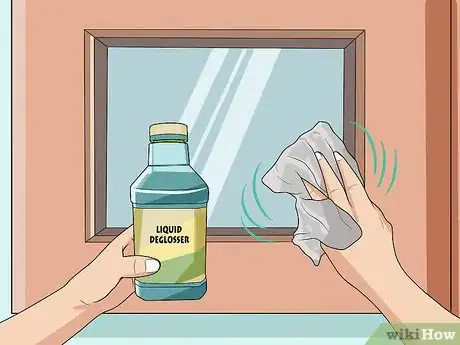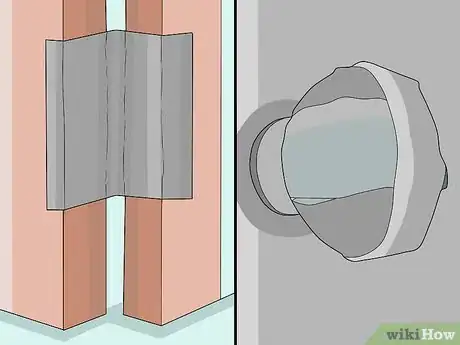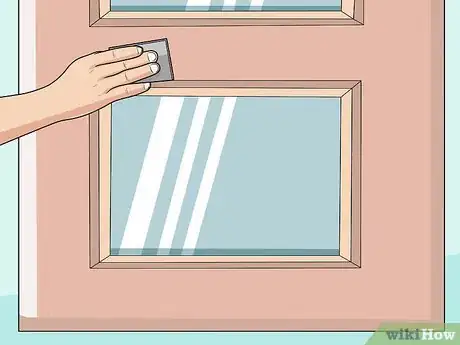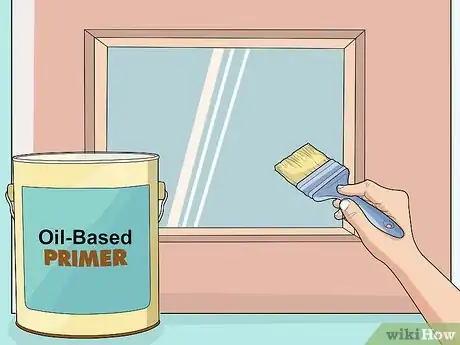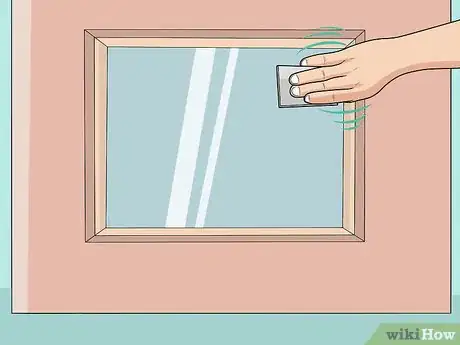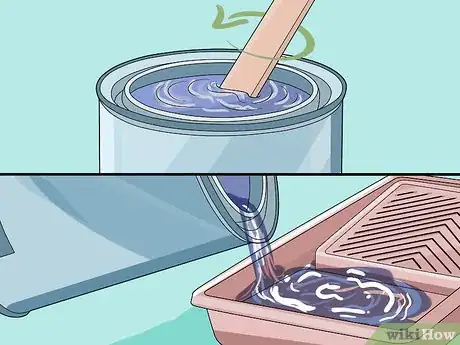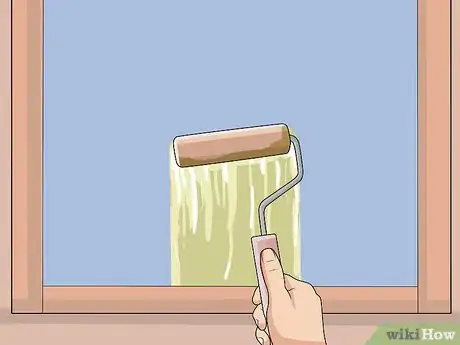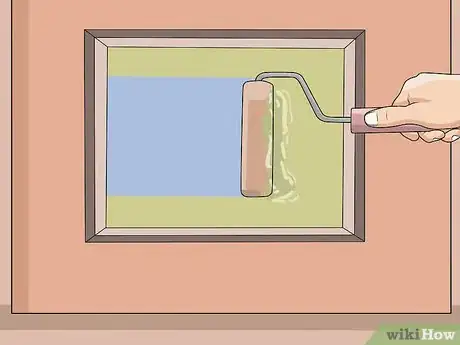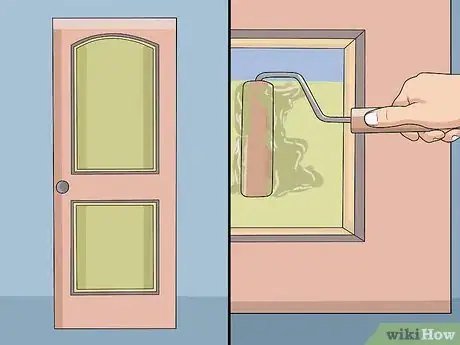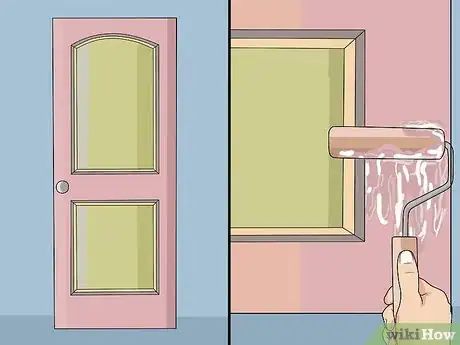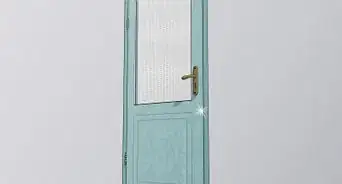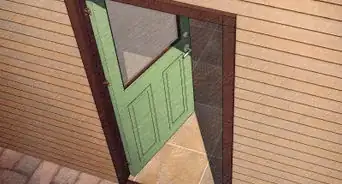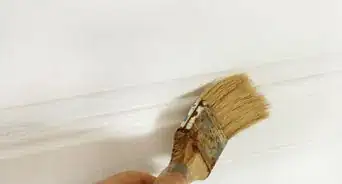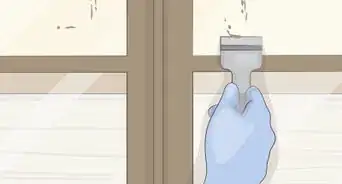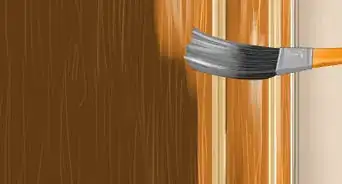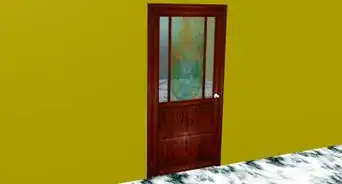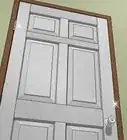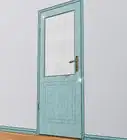This article was co-authored by Jeff Baldwin. Jeff Baldwin is a Residential Painter and the Owner of Baldwin Custom Painting. With two decades of painting experience, Jeff specializes in high-end residential and small commercial painting projects. Dedicated to quality craftsmanship, Jeff and Baldwin Custom Painting provide bonded/insured, licensed, and lead-safe certified services in residential painting, light commercial painting, and wood refinishing.
There are 10 references cited in this article, which can be found at the bottom of the page.
This article has been viewed 18,475 times.
Painting the doors inside your house is a great way to rejuvenate a room. Before you start painting, you’ll have to clean, sand, and prime your door. If you prepare and have the right materials, you’ll be ready to paint your door to perfection!
Steps
Removing and Cleaning the Door
-
1Clean the space where you will paint the door. Sweep the floors and make sure any dust and dirt is gone. You don’t want anything sticking to the wet paint and ruining your paint job. Make sure you will be painting in a well-ventilated area.[1] Put drop clothes or cardboard on the floor to protect it from spilled paint.[2]
-
2Remove the door from the wall. Have someone help you with this task by holding the door as you remove the hinge pins with a flat screwdriver by pressing up lightly. Then unscrew the hinges with a screwdriver or drill. Place the door on sawhorses or on the floor.[3]Advertisement
-
3Leave the door on its hinges if it is a flat door. You can also leave a paneled door on its hinges, though it might result in more paint runs than laying the door flat. Leaving on its hinges makes it possible to paint both sides of the door at once, instead of waiting for it to dry and then flipping it.[4]
-
4Clean the door with a liquid deglosser and a rag. If the door is dusty, dirty, or greasy, the paint won’t stick as well.[5] Focus especially on cleaning around the door knob. After you’ve wiped down the door, wipe it dry with a clean rag.[6]
- Wear rubber gloves when handling deglossers, primers, and paint.
- One cleaner you could use is TSP (trisodium phosphate), which is a powder you dissolve in warm water.[7]
-
5Protect the door hinges and knobs. You can either remove them, or cover them with rubber cement or tape. Make sure you keep the screws with the fixtures you have removed in a safe place, so that you'll be able to put them on again when you are done.
Sanding and Priming
-
1Determine if the door is painted with oil-based or latex paint. Rub a little rubbing alcohol onto the door, and if the paint comes off, it is latex. If it’s latex you can skip the following sanding and priming steps, though you’ll have to sand and prime if the paint is oil-based.[8]
-
2Sand the door lightly using fine grit sandpaper or sanding block. You don’t need to use a power sander. Make sure to sand the entire door to create a smooth, even surface. Remove any sawdust with a damp rag.[9]
-
3Paint the door with an oil-based primer. Paint the counters of the door with primer first, and then use a roller for the flat surfaces.[10] Let the primer dry before painting.[11]
- Your primer should be a similar shade to the final paint color.[12]
- Make sure to use interior primer for your interior door.
-
4Sand the door again once the primer has dried. Drying the primer could take 1-3 hours, and maybe even longer if you are in a humid place. Sand lightly and evenly, just like the first time. Wipe off the door with a damp cloth to remove any sawdust and let the door dry again before painting.
Painting the Door
-
1Stir your paint and pour it into a roller tray. Paint cans are usually pretty clearly marked if they are for exterior or interior use, so make sure you have interior paint before beginning. Stir the paint well using a stirring stick until it’s not separated and doesn't have lumps.
-
2Use a 9-inch roller to paint the whole door if it doesn’t have panels. Mix the paint with a stirring stick and pour it into a roller tray. Roll with long, even strokes. Be sure to paint in the same direction as the wood grain. Paint the edges of the door last.
-
3Paint the recessed panels, the horizontal rails and then the vertical stiles if the door has panels. Use a small roller to quickly roll on the paint. Then use a brush to smooth it out and fill in missed spots. The brush should be going in the same direction as the wood grain. Paint the edges of the door last.[13]
- Smooth out any paint drips on the door with your paint brush.
-
4Let the door dry and then do a second coat. Drying could take an hour or longer. You may have to sand between coats. Apply the second coat in the same way you did the first.[14]
-
5Paint the other side of the door using the same process. Once the door has dried, you'll have to put the door back on its hinges and return any hardware you removed, like doorknobs. Then you can enjoy the new, clean door that you painted yourself.
Expert Q&A
-
QuestionWhat should I do if I want to reuse my paint roller?
 Jeff BaldwinJeff Baldwin is a Residential Painter and the Owner of Baldwin Custom Painting. With two decades of painting experience, Jeff specializes in high-end residential and small commercial painting projects. Dedicated to quality craftsmanship, Jeff and Baldwin Custom Painting provide bonded/insured, licensed, and lead-safe certified services in residential painting, light commercial painting, and wood refinishing.
Jeff BaldwinJeff Baldwin is a Residential Painter and the Owner of Baldwin Custom Painting. With two decades of painting experience, Jeff specializes in high-end residential and small commercial painting projects. Dedicated to quality craftsmanship, Jeff and Baldwin Custom Painting provide bonded/insured, licensed, and lead-safe certified services in residential painting, light commercial painting, and wood refinishing.
Residential Painter Scrape the paint from the sleeve and rinse it in the sink. You can use soap to get it extra clean, and if you want it to be soft for the next time you paint, add some Cream Rinse conditioner and rinse it out.
Scrape the paint from the sleeve and rinse it in the sink. You can use soap to get it extra clean, and if you want it to be soft for the next time you paint, add some Cream Rinse conditioner and rinse it out. -
QuestionWhich primer should I use for wood?
 Jeff BaldwinJeff Baldwin is a Residential Painter and the Owner of Baldwin Custom Painting. With two decades of painting experience, Jeff specializes in high-end residential and small commercial painting projects. Dedicated to quality craftsmanship, Jeff and Baldwin Custom Painting provide bonded/insured, licensed, and lead-safe certified services in residential painting, light commercial painting, and wood refinishing.
Jeff BaldwinJeff Baldwin is a Residential Painter and the Owner of Baldwin Custom Painting. With two decades of painting experience, Jeff specializes in high-end residential and small commercial painting projects. Dedicated to quality craftsmanship, Jeff and Baldwin Custom Painting provide bonded/insured, licensed, and lead-safe certified services in residential painting, light commercial painting, and wood refinishing.
Residential Painter You can use white pigmented shellac. It is stain-resistant and smooth. It also dries fast and can be sanded easily.
You can use white pigmented shellac. It is stain-resistant and smooth. It also dries fast and can be sanded easily. -
QuestionHow can I get rid of paint smells?
 Jeff BaldwinJeff Baldwin is a Residential Painter and the Owner of Baldwin Custom Painting. With two decades of painting experience, Jeff specializes in high-end residential and small commercial painting projects. Dedicated to quality craftsmanship, Jeff and Baldwin Custom Painting provide bonded/insured, licensed, and lead-safe certified services in residential painting, light commercial painting, and wood refinishing.
Jeff BaldwinJeff Baldwin is a Residential Painter and the Owner of Baldwin Custom Painting. With two decades of painting experience, Jeff specializes in high-end residential and small commercial painting projects. Dedicated to quality craftsmanship, Jeff and Baldwin Custom Painting provide bonded/insured, licensed, and lead-safe certified services in residential painting, light commercial painting, and wood refinishing.
Residential Painter Instead of using smelly paint additives, you can open windows, turn on the fireplace, or burn candles to get rid of paint smells.
Instead of using smelly paint additives, you can open windows, turn on the fireplace, or burn candles to get rid of paint smells.
Things You’ll Need
- Rubber gloves
- Drop cloths
- Fine-grit sandpaper
- TSP (if you need it)
- Primer (if you need it)
- Fresh sponges
- Rags
- Paint
- Paintbrush
- Paint tray
- Roller
References
- ↑ Jeff Baldwin. Residential Painter. Expert Interview. 1 March 2021.
- ↑ https://www.homedepot.com/c/ah/how-to-paint-interior-doors/9ba683603be9fa5395fab9096769bfd
- ↑ https://www.prettyhandygirl.com/removing-door-knobs-latches-and-hinges/
- ↑ https://www.glidden.com/inspiration/all-articles/how-to-paint-an-interior-door
- ↑ Jeff Baldwin. Residential Painter. Expert Interview. 1 March 2021.
- ↑ https://www.blesserhouse.com/how-to-paint-interior-doors/
- ↑ https://www.bhg.com/decorating/paint/how-tos/how-to-prep-paint/
- ↑ Jeff Baldwin. Residential Painter. Expert Interview. 1 March 2021.
- ↑ https://www.bhg.com/decorating/paint/room/how-to-paint-a-door/
- ↑ Jeff Baldwin. Residential Painter. Expert Interview. 1 March 2021.
- ↑ https://www.prettyhandygirl.com/how-to-paint-doors-the-professional-way
- ↑ https://homeguides.sfgate.com/paint-door-primer-31476.html
- ↑ https://www.prettyhandygirl.com/how-to-paint-doors-the-professional-way/
- ↑ https://www.prettyhandygirl.com/how-to-paint-doors-the-professional-way/
